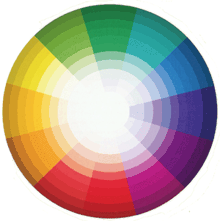|
This web site was put together
as a research project with the goal of discovering
cultural
similarities (and differences) based on color association,
preference, and internet activities. I posted a
survey
in late January 2003 with the goal of obtaining 500+
results. My initial hope was that with
500 responses there would be enough data from cultures
outside
the United
States
that the comparison of two or more cultures would
be possible. When I closed the survey in early March
2003 I had only gathered 232 results (79.3% coming
from the USA and the other ~20% divided amongst 21
other countries). |

Figure 2.1 - color Wheel 1 |
With a noticeable lack
of international data, the aforementioned cultural comparisons
were not justified. Moreover, the time constraints of a
short winter quarter at the University of Washington have
provided sufficient motivation to alter the focus of my
research.
Cultural similarities
and differences will not be included in this project (although
I hope that someday…someone might pick up where I
left off); nevertheless, the research focuses on four sections:
First, words like trust, quality, and desperation (to name
a few) and the colors the participants associated with
these words will be examined. The goal of this section
will be to discover trends (or lack thereof) between a
standard list of colors and a list of words that may (at
first look) seem to have no association with any color.
Second, correlations between the aforementioned color
sets and published research on color preference are investigated.
Related to this, the next section will examine color psychology
and some possible reasons for the color choices by the
participants. Examining differences, and similarities,
between already published information and the survey results
will help present a qualitative perspective of the data
collected in the color questionnaire. The fourth (and
final) step is to correlate these results to online activities.
In the survey, questions regarding the importance of a
variety of online activities (e.g. shopping & communicating,
to name a few) were asked, and this part of the project
will focus on possible color combinations to help designers
make better color choices for using, or not using, specific
colors.
Site Instructions:
Unlike most formal academic research
projects, this study is published as a web site. A
web site
can reflect the qualities found in a traditional research
paper (e.g. an introduction, methods, results, parenthetical
references, etc.) as well as the qualities of a dynamic
document. This research project allows you to navigate
through the document using several paths. If you wish
to navigate the document in a non-linear fashion you
can
use the navigation buttons at the top of each page to
jump to any of the sections. If you wish to read this
study in a linear fashion you can use the “Next”
and “Previous” buttons at the bottom of each
page. Using these buttons will take you (in order) through
the entire project much like turning the pages of a book.
If you have any questions, see any
mistakes, or just want to communicate with me, you
can
reach me through my contact
form.
Site Outline:
|